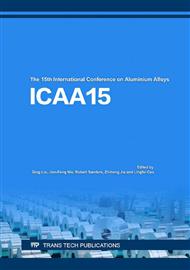[1]
X. Wang, W.J. Poole, S. Esmaeili, D.J. Lloyd, J.D. Embury, Precipitation strengthening of the aluminum alloy AA6111, Metall. Mater. Trans. 34A (2003) 2913–2924.
DOI: 10.1007/s11661-003-0191-0
Google Scholar
[2]
T. Masuda, Y. Takaki, T. Sakurai, S. Hirosawa, Combined effect of pre-straining and pre-aging on bake-hardening behavior of an Al-0. 6 mass% Mg-1. 0 mass% Si alloy, Mater. Trans. 51 (2010) 325–332.
DOI: 10.2320/matertrans.l-m2009831
Google Scholar
[3]
S. Pogatscher, H. Antrekowitsch, H. Leitner, T. Ebner, P.J. Uggowitzer, Mechanisms controlling the artificial aging of Al–Mg–Si Alloys, Acta Mater. 59 (2011) 3352–3363.
DOI: 10.1016/j.actamat.2011.02.010
Google Scholar
[4]
J. Banhart, M. Liu, Y. Yong, Z. Liang, C.S.T. Chang, M. Elsayed, M.D.H. Lay, Study of ageing in Al-Mg-Si alloys by positron annihilation spectroscopy, Physica B407 (2012) 2689–2696.
DOI: 10.1016/j.physb.2012.03.028
Google Scholar
[5]
L. Cao, P.A. Rometsch, M.J. Couper, Effects of natural aging after pre-aging on clustering and bake-hardening behavior in an Al–Mg–Si alloy, Mater. Sci. Eng. A559 (2013) 257–261.
DOI: 10.1016/j.scriptamat.2016.01.019
Google Scholar
[6]
Y. Aruga, M. Kozuka, Y. Takaki, T. Sato, Soft X-ray XAFS studies on Al–Mg–Si alloys with different aging conditions, Metall. Mater. Trans. 45A (2014) 5906–5913.
DOI: 10.1007/s11661-014-2548-y
Google Scholar
[7]
O.R. Myhr, Ø. Grong, Modelling of non-isothermal transformations in alloys containing a particle distribution, Acta Mater. 48 (2000) 1605–1615.
DOI: 10.1016/s1359-6454(99)00435-8
Google Scholar
[8]
O.R. Myhr, Ø. Grong, S.J. Andersen, Modelling of the age hardening behaviour of Al–Mg–Si alloys, Acta Mater. 49 (2001) 65–75.
DOI: 10.1016/s1359-6454(00)00301-3
Google Scholar
[9]
O.R. Myhr, Ø. Grong, K.O. Pedersen, A combined precipitation, yield strength, and work hardening model for al-mg-si alloys, Metall. Mater. Trans. 41A (2010) 2276–2289.
DOI: 10.1007/s11661-010-0258-7
Google Scholar
[10]
O. R. Myhr, Ø. Grong, C. Schäfer, An extended age-hardening model for Al-Mg-Si alloys incorporating the room-temperature storage and cold deformation process stages, Metall. Mater. Trans. 46A (2015) 6018–6039.
DOI: 10.1007/s11661-015-3175-y
Google Scholar
[11]
O.G. Lademo, O. Engler, S. Keller, T. Berstad, K.O. Pedersen, O.S. Hopperstad, Identification and validation of constitutive model and fracture criterion for AlMgSi alloy with application to sheet forming, Mater & Design. 30 (2009) 3005–3019.
DOI: 10.1016/j.matdes.2008.12.020
Google Scholar
[12]
O. Engler, C. Schäfer, O.R. Myhr, Effect of natural ageing and pre-straining on strength and anisotropy in aluminium alloy AA 6016, Mater. Sci. Eng. A639 (2015) 65–74.
DOI: 10.1016/j.msea.2015.04.097
Google Scholar
[13]
R.A. Lebensohn, C.N. Tomé, A self-consistent anisotropic approach for the simulation of plastic deformation and texture development of polycrystals: application to zirconium alloys, Acta Metall. Mater. 41 (1993) 2611–2624.
DOI: 10.1016/0956-7151(93)90130-k
Google Scholar
[14]
O. Engler, V. Randle, Introduction to texture analysis: macrotexture, microtexture and orientation mapping, 2nd ed., CRC Press, Boca Raton, FL, (2010).
DOI: 10.1107/s0021889810014548
Google Scholar
[15]
G.J. Baczynski, R. Guzzo, M.D. Ball, D.J. Lloyd, Development of roping in an aluminum automotive alloy AA6111, Acta Mater. 48 (2000) 3361–3376.
DOI: 10.1016/s1359-6454(00)00141-5
Google Scholar
[16]
O. Engler, J. Hirsch, Texture control by thermomechanical processing of AA6xxx Al–Mg–Si sheet alloys for automotive applications—a review, Mater. Sci. Eng. A336 (2002) 249–262.
DOI: 10.1016/s0921-5093(01)01968-2
Google Scholar
[17]
T.A. Bennett, J. Sidor, R.H. Petrov, L.A.I. Kestens, The effect of intermediate annealing on texture banding in aluminum alloy 6016, Adv. Eng. Mater. 12 (2010) 1018–1023.
DOI: 10.1002/adem.201000072
Google Scholar
[18]
O. Engler, C. Schäfer, H. -J. Brinkman, Crystal-plasticity simulation of the correlation of microtexture and roping in AA 6xxx Al–Mg–Si sheet alloys for automotive applications, Acta Mater. 60 (2012) 5217–5232.
DOI: 10.1016/j.actamat.2012.06.039
Google Scholar


